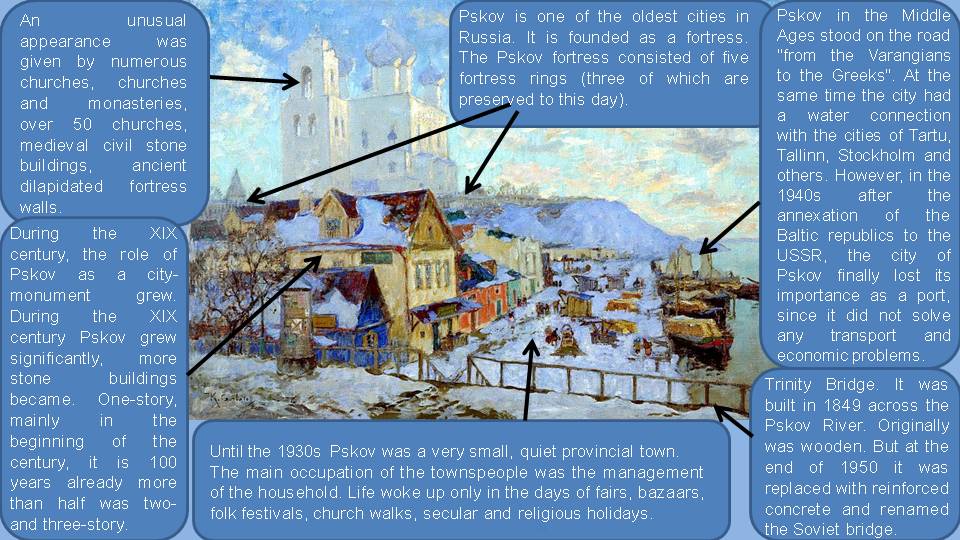PSKOV (K. I. Gorbatov, 1910)
This painting was painted by the Russian artist Gorbatov Konstantin Ivanovich (1876-1945). The city of Pskov took a special place in his canvases, he devoted more than 30 works. In 1910 he was awarded the second prize at the Spring Exhibition of the Imperial Academy of Arts for one of these paintings. Later, all these paintings were exhibited at various exhibitions. This picture shows the river Pscova, the inner port and the fish market. At this time the port of Pskov was already an important type of economic activity. The main important activity was transportation of goods. To the left of the market you can see houses with shops on the 1st floor. In the background, the walls of the Kremlin are depicted, followed by the Trinity Cathedral.
The Pskov Region is in the northwest of the Russian Plain. It is stretched by a narrow strip from the north-west to the south-east. The city itself is located on both sides of the river Great places of confluence of the Pskov River in it. All major historical zones in these three rivers. The central part of the city includes the territory inside the walls of the Roundabout, bounded by the Velikaya and Pskov. The Zapkovye region is given a place on the right bank of Pskov, and Zavelichye is located on the left bank of the Velikaya. The shores of the Velikaya are connected by three bridges. Near the Kremlin is the Olginsky Bridge, which connects the main street of the right bank – Oktyabrsky Prospekt, with the main thoroughfare of Zavelich – Riga Avenue. Two more bridges – the 50th anniversary of October and Alexander Nevsky – are respectively higher and lower in the course of the Velikaya.
Pskov is a city and administrative center of the Pskov region, Russia, located about 20 kilometers from the east coast of Estonia, on the Velikaya River. When was built Pskov is unknown. The first mention of it in the annals dates back to 903, at that time it was already a major trading city. It was built between the two great rivers Velikaya and Pskov. Over time, Pskov did not expand like all Russian cities are concentrated in circles, but where there was a more likely threat of attack.
Facades of buildings of the late XVIII – early XIX centuries. were solved in accordance with the compositional schemes of classicism. At the same time in Pskov, the most widespread was the non-disordered version of the style – without columns and pilasters. In case of access to the warrant, pilasters were sometimes used. Columns were rarely used, usually in church buildings. On the central streets of the city, new buildings were built with upper floors made of wood and the first floors of stone, they usually housed benches. . The second half of the XIX – early XIX centuries. became the most fruitful period in the construction life of the province of Pskov. In the construction of the city, new types of buildings, unknown before, appeared: profitable houses, banks, a railway station, etc. Old wooden houses were demolished, and large stone buildings were erected in their place. The number of storeys of erected buildings (up to five floors) increased. Widely used in the construction of houses began to find metal and glass, and at the end of the century – reinforced concrete. Since the 1880’s. began to use sewage and water, and from the beginning of the XX century. – power supply, ventilation and air conditioning system.
During the 18-19th centuries the Pskov province developed as an agrarian province, with a small number of working population. In the markets and squares, flax was sold, which was processed here, fur, honey, wax and fish. They bought salt, cloth, iron. One of the reasons for the weak development of industry in the province was the lack of resources of minerals. For this reason, metalworking, for example, was forge in the industry. By the end of the 19th century, the first newspaper had begun to appear in Pskov, the construction of a railway had begun and a water pipeline had been built.
During the First World War (1914-1918) Pskov became the center of great activity behind the lines. It was on the railway in Pskov aboard the imperial train that Tsar Nicholas II signed a manifesto announcing his abdication in March 1917, and after the Russo-German Brest-Litovsk peace conference (December 22, 1917 – March 3, 1918), the German Imperial Army Intruded into this area. Pskov was also occupied by the Estonian army from May 25, 1919 to August 28, 1919 during the Estonian War of Independence.
During the First World War (1914-1918) Pskov became the center of great activity behind the lines. It was on the railway in Pskov aboard the imperial train that Tsar Nicholas II signed a manifesto announcing his abdication in March 1917, and after the Russo-German Brest-Litovsk peace conference (December 22, 1917 – March 3, 1918), the German Imperial Army Intruded into this area. Pskov was also occupied by the Estonian army from May 25, 1919 to August 28, 1919 during the Estonian War of Independence.
Anna Chernyshova

